Recently, the Kitchener Waterloo Gem and Mineral Club undertook a field trip to the Madoc-Marmora area of Southern Ontario. We visited three localities and recovered interesting minerals from each.
Rogers Mine: The Rogers Mine is an old fluorite mine that I first visited 40 years ago (fourty?! Wow!). In those days, there was a fair amount of open, well drained pasture surrounding the mine but now it is pretty well all forest. In addition, the beavers have been busy damming up running water so that the area is very broken up by beaver ponds and swamps now. Very difficult to get around in!! We did find it and After tromping around in the woods for a couple of hours, we finally found the Rogers Mine and collected on the old mine dump. The main mineral of interst was boulangerite, which occurs in fantastic micro "rings" as well as the normal hairy and needle. See the images in this report to see what I mean. We also found lots of small fluorite and sphalerite crystals, massive barite, calcite, etc.
Ackerman Mine: If you have a stong reaction to poison Ivy, stay away from this place!! It is LOADED with poison ivy! Anyway, it is easy to access, just off Hwy #7 and easy to dig in the dump to find well-formed arsenopyrite crystals in the calcite or attached to rough quartz crystals.
Marmora Mine: The dumps at this long closed iron mine are being re-worked for aggregate and armour stone. This ensures that a constant supply of garnet, epidote, pyrite, actinolite, etc crystals are exposed in boulders on the dumps. Most of the crystals are encloded in calcite and you need to put them in acid to expose the crystals.
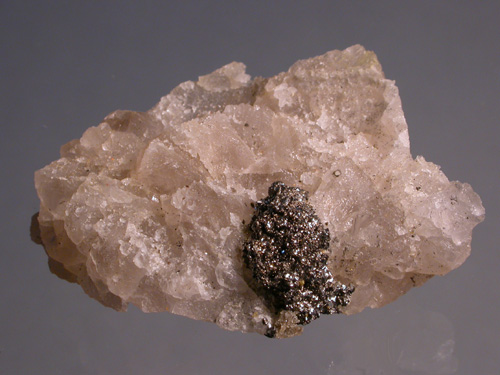
Here is a small specimen, about 50mm across that I collected at the Ackerman Mine during this trip. It was originally covered wit hmassive calcite which I etched off with hydrochloric acid. Not particularly impressive but not bad!! The price was right! Arsenopyrite crystals up to 10mm and larger occur regularly at the mine. The trick is to find piece that you can etch and leave some great arsenopyrite crystals attached to the quartz or protruding from the calcite. For information only. Not for sale.
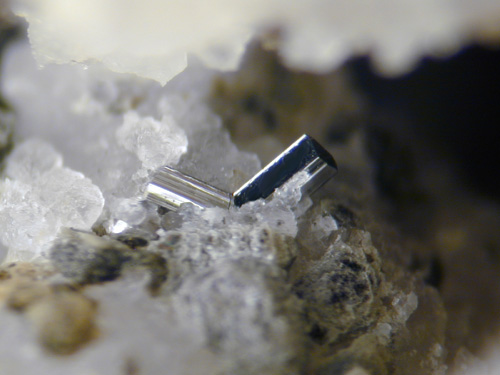
A nice 3mm or so twin (?) of arsenopyrite in a vug in quartz/chlorite from the Ackerman Mine. For information only. Not for sale.

Here is a view of two micro boulangerite rings. Well, at least the one on the left is boulangerite. The smaller one on the right is pseudomorphed bindheimite (pers. comm., R. Mielke). For information only. Not for sale.
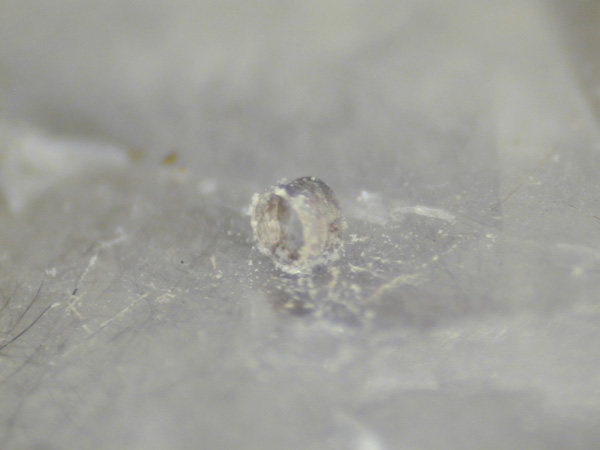
This ring, almost a cylinder appears to be not be boulangerite, any longer but is oxidized to binheimite (ref. R. Mielke).

Here is an interesting one! A beautiful, metallic ring between two calcite crystals with a smaller ring inserted in it! I love these rings! For information only. Not for sale.

Another metallic boulangerite ring. For information only. Not for sale.
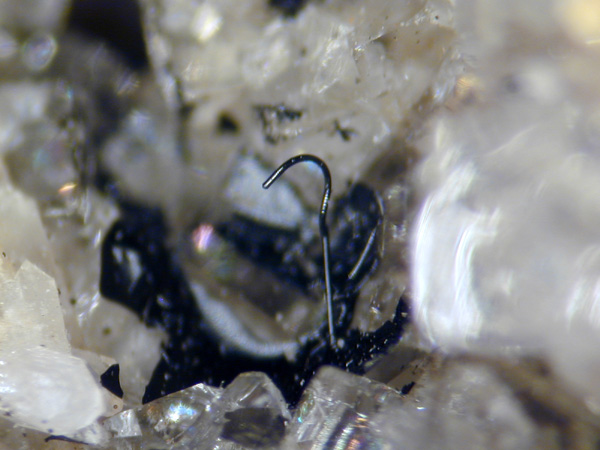
This is an odd one! Reiner Meilke found this specimen and noticed what appears to be a boulangerite "hook" coated by hydrocarbon. Many minerals at the Rogers Mine do occur coated with hydrocarbon. What do you think? For information only. Not for sale.

Jeff Shallit is a key member of the Kitchener-Waterloo Club and organized the communications and logistics for this field trip. He is also a member of the Walker Mineralogical Club!
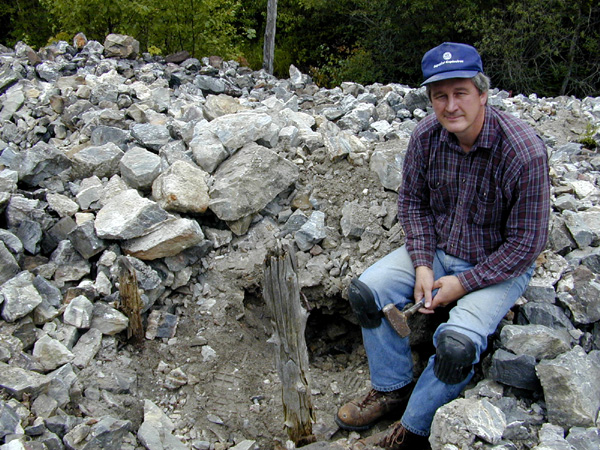
Here I am digging a hole in the mine dump at the Rogers Mine, near Madoc. On/in the dump you will find chunks of vein material containing sulphides, sulphosalts, barite, calcite and fluorite. In some of the chunks, you'll find vugs in, usually, calcite or fluorite containing hairs-like crystals of boulangerite. Hopefully, you will find boulangerite "rings" or "cylinders" like the ones pictured below. These crystals are very tiny and you really need a microscope to appreciate them. Why do they do this!? and only once in a while!

This is Reiner Meilke who led the field trip to the Rogers Mine. He is a seasoned geologist with a sixth sense in the woods. He got us there and out again!
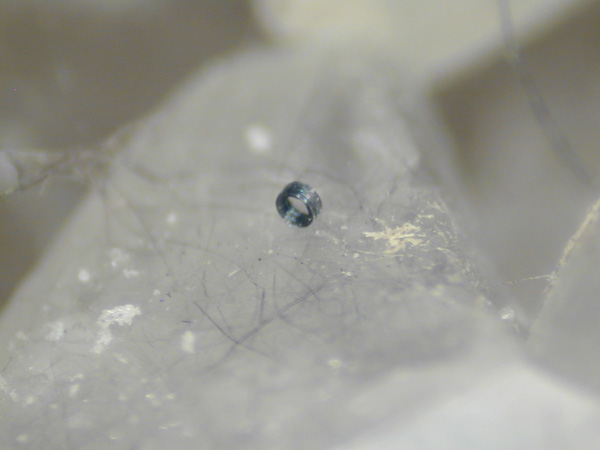
A beautiful, well shaped, lustrous metallic short-cylinder of coiled boulangerite. For information only. Not for sale.

These garnets are typical of specimens that are easily found on the old dumps of the Marmoraton Iron Mine, a skarn-type of deposit. Garnets are either dodecahedra or trapezohedra at this locality. I collected this specimen recently. For information only. Not for sale.
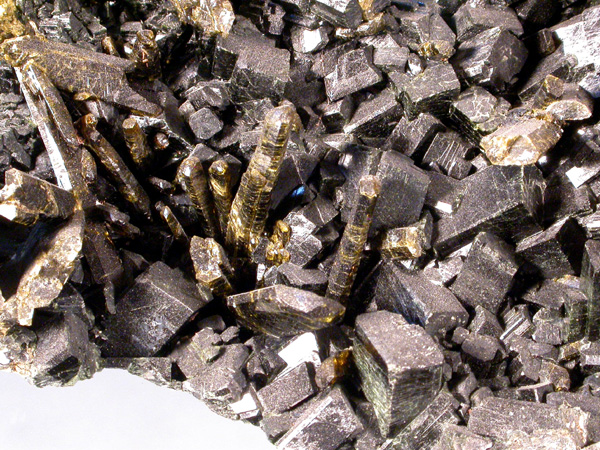
You can find some very nice epidote at Marmora. Here is a fine example of elongated, olive green epidote crystals poking out from amongst very dark green, almost black, very sharp pyroxene group mineral. Field of view 8.0cm. For information only. Not for sale.

Here is a picture of George Thompson sledging a boulder at the Marmora Mine. Man that guy can work!!

Here I am watching George work on another boulder containing nice garnet crystals. I enjoy watching George work and could probably do it all day!

24mm across. For information only. Not for sale.
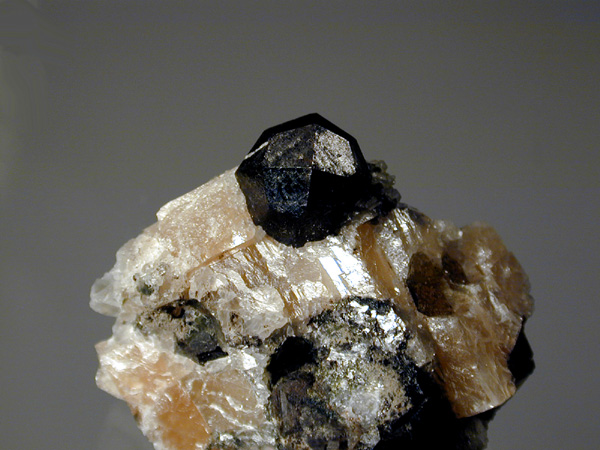
A very nice little specimen showing an 11mm, dark red trapezohedral garnet crystal exposed in orange calcite. Obviously, this one has not been treated in acid. For information only. Not for sale.